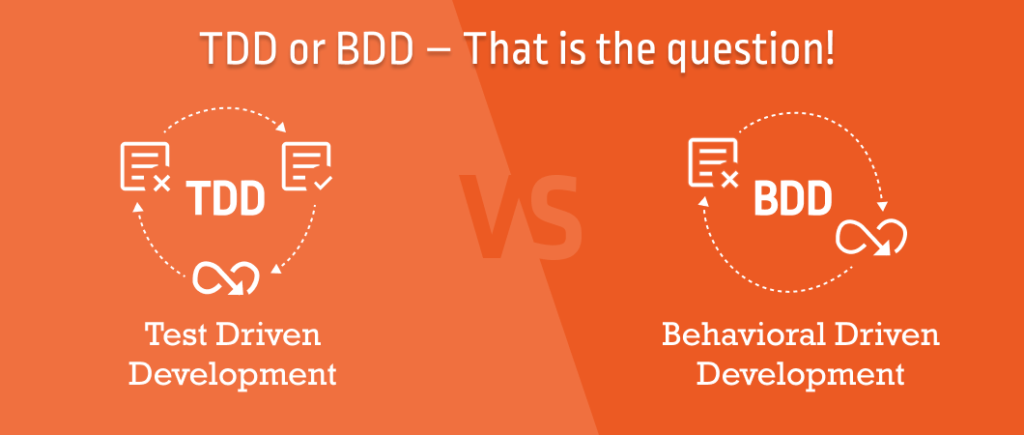Last updated on January 18th, 2022
BDD vs TDD-Behavior Driven Development vs Test Driven Development
“TDD vs BDD” is a phrase that a lot of people especially in the SaaS product community are increasingly paying attention to now. For those who are not fully aware of what is TDD and BDD; they are among the most widely used testing methodologies in software development today. Let us explain each briefly:
What is TDD in agile software development?
TDD stands for Test Driven Development, a testing methodology that works on how well a functionality is aligned and meets a written test case. As the software progresses in its evolution path in tandem with the business’s digital goals, this method may not yield exact and efficient results. The problem here is that with TDD, the original test case may not be sufficient to cover the evolutionary stages of the product, and hence of the code under test. Hence there may be false test results that could be produced.
What is BDD in agile software development?
BDD has its roots based in a test-first approach, but it focuses on testing the behavior of the system over periods of usage. BDD is short for Behavior Driven Development, and it has been conceived to ensure that an application performs and showcases the expected behavior when end-users will use the system. Hence when the application code is modified to add new features or customized, BDD ensures that the expected behavior for the new code is tested and certified.
So, from the above overview, one may assume that the BDD vs TDD battle is already won by BDD. But the debate is not so easily done. Both are useful for their respective utilities. While the writing of test cases occurs before coding for both approaches, there are considerable differences elsewhere.
Let us examine the key differences between TDD and BDD test methodologies and do a comparative study:
Output Focus
In TDD, the testing logic is not concerned about the output and focuses all efforts on carrying out the testing activities according to the way that the written test script is executed. As the system or application evolves over time, it may give false results for the test scenarios initially written. For BDD, the focus is on ensuring that the output is correct for any situation or behavior that the application exhibits over a period of evolution. Under a given condition, BDD ensures that the system performs in a specific manner in alignment with the requirements of the new condition.
Communication Preferences
BDD scores tremendously in the BDD vs TDD battle when communication and feedback propagation methods are examined. The usage of non-technical language in BDD, wherein the expected outcomes for the application are explained in plain language, helps more product owners and business users to understand and participate in the testing phase. On the other hand, TDD is focused more on developers and centered around the practice of developing and testing code. When developers want feedback from product owners or stakeholders, BDD allows a simpler communication line to exist, wherein more accurate feedback can be propagated.
Code Quality
While communication is BDD’s biggest strength, code quality turns out to be the USP of TDD. TDD works for a developer and satisfies their quest to improve code quality. While faced with failing test cases, developers would be able to craft a much more precise test case while not focusing on specifying an exact behavior. This usually will result in better code quality. BDD on the other hand has to satisfy both developers and customers which results in far more generic feedbacks that developers may not comprehend in their feedback integration initiatives.
Who’s Involved
BDD focuses on a larger audience for test execution and must consider their inputs as well. The stakeholders for a BDD approach include developers, test engineers, product managers, client-side representatives, and any other representation from core business users. TDD doesn’t have such a complex network of considerations to be accounted for in execution. TDD allows software developers to carry out testing on their own without the need for inputs from a product manager or any other stakeholder. They do not need an external force or input to work on improving outcomes. This could make things faster and less complex to manage and execute.
Target Applications
BDD, being more centered, around business objectives makes for a great choice of testing in domains like eCommerce, booking websites, etc. where user actions have a greater say in deciding the utility and experience to be provided by the application. TDD is great for projects that involve APIs and 3rd party tools wherein the functional integrity of individual components of the code is more important.
It is in fact incorrect to assume that there is a BDD vs TDD battle today as both have their own set of advantages and shortcomings. The best option is to have a combined strategy where BDD executes on top of TDD to ensure that the overall application is sturdy for users and free from technical faults at the code level. This makes for a win-win situation for all stakeholders. To get the strategy right, it is important to have a clear roadmap of implementing both these approaches across the length and breadth of an organization’s technology backend. This is where an expert partner can make a difference. Get in touch with us to know more about building better applications with more innovative and effective testing strategies.



